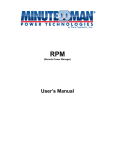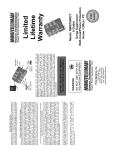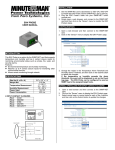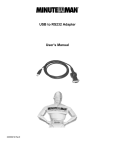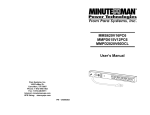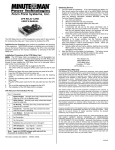Download Minute Man SSL-SMOKE smoke detector
Transcript
2. Connect the wires from the SSL-SMOKE detector to the SSL-EMD Alarm-1 and/or Alarm-2, and then tighten the screws. SSL-SMOKE User’s Manual IMPORTANT: Read all of the instructions attempting to install the SSL-SMOKE detector. before DESCRIPTIONS The SSL-SMOKE detector is a device, which connects with SSL-EMD. When smoke is detected an alarm will sound alerting the users. Through the SNMP-SSL card, the user can monitor it and receive notifications of the alarms. This type of AC/DC smoke detector can be powered by 120VAC utility power or a 9-volt battery. AC/DC smoke detectors offer added protection in the event of a power failure or a dead battery. INSTALLATION 1. Detach the cover by twisting it until it unlatches from the smoke detector base. 2. Using the smoke detector base as pattern, trace outlines of the two keyhole slots onto the mounting surface. 3. Drill a pilot hole in the center of the small end of each of the keyhole slots in the mounting surface. 4. Insert and tighten the mounting screws in the pilot holes leaving approximately 1/8” of the screws sticking out. 5. Mount the smoke detector base making sure that screws are positioned in the small ends of the keyholes and tighten the screws. 6. Snap on the battery wire clip and insert the battery into battery holder. 7. Replace the cover by twisting it until it latches. The smoke detector is now operating. 8. Test the smoke detector by pushing test button on cover and holding the button down for about 2-seconds. 3. Connect the straight-through CAT5 network cable from the SNMP-SSL card’s RJ45 connector labeled “COM” to the connector labeled “010101” on the SSL-EMD. LIMITED PRODUCT WARRANTY Para Systems Inc. (Para Systems) warrants this equipment, when properly applied and operated within specified conditions, against faulty materials or workmanship for a period of three years from the date of original purchase by the end user. For equipment sites within the United States and Canada, this warranty covers repair or replacement of defective equipment at the discretion of Para Systems. Repair will be from the nearest authorized service center. Replacement parts and warranty labor will be borne by Para Systems. For equipment located outside of the United States and Canada, Para Systems only covers faulty parts. Para Systems products repaired or replaced pursuant to this warranty shall be warranted for the remaining portion of the warranty that applies to the original product. This warranty applies only to the original purchaser who must have properly registered the product within 10 days of purchase. The warranty shall be void if (a) the equipment is damaged by the customer, is improperly used, is subjected to an adverse operating environment, or is operated outside the limits of its electrical specifications; (b) the equipment is repaired or modified by anyone other than Para Systems or Para Systems-approved personnel; or (c) has been used in a manner contrary to the product's operating manual or other written instructions. 4. Verify that the SNMP-SSL card has a network connection and is powered on. 5. Check the LED (Power/Status) of SSL-EMD, it will flash every 5-seconds. 6. Open a Web browser and connect to the SNMP-SSL card. 7. Change the setting of “SSL-EMD Status” from “Disable” to “Auto” on the EMD Configuration page. 8. Set the status of Alarm-1 and/or Alarm-2 to “Normal Open”. Any technical advice furnished before or after delivery in regard to use or application of Para Systems’s equipment is furnished without charge and on the basis that it represents Para Systems’s best judgment under the circumstances, but it is used at the recipient's sole risk. EXCEPT AS PROVIDED HEREIN, PARA SYSTEMS MAKES NO WARRANTIES, EXPRESSED OR IMPLIED, INCLUDING WARRANTIES OF MERCHANTABILITY AND FITNESS FOR A PARTICULAR PURPOSE. Some states do not permit limitation of implied warranties; therefore, the aforesaid limitation(s) may not apply to the purchaser. EXCEPT AS PROVIDED ABOVE, IN NO EVENT WILL PARA SYSTEMS BE LIABLE FOR DIRECT, INDIRECT, SPECIAL, INCIDENTAL, OR CONSEQUENTIAL DAMAGES ARISING OUT OF THE USE OF THIS PRODUCT, EVEN IF ADVISED OF THE POSSIBILITY OF SUCH DAMAGE. Specifically, Para Systems is not liable for any costs, such as lost profits or revenue, loss of equipment, loss of use of equipment, loss of software, loss of data, cost of substitutes, claims by third parties, or otherwise. The sole and exclusive remedy for breach of any warranty, expressed or implied, concerning Para Systems’s products and the only obligation of Para Systems hereunder, shall be the repair or replacement of defective equipment, components, or parts; or, at Para Systems’s option, refund of the purchase price or substitution with an equivalent replacement product. This warranty gives you specific legal rights and you may also have other rights, which vary from state to state. Use the following steps to set-up and connect the SSL-SMOKE detector to the SSL-EMD: 1. Loosen the screws on SSL-EMD. 9. The installation of the SSL-SMOKE detector is complete. See the SNMP-SSL User’s Manual. Note: The SSL-SMOKE detector operates with 120VAC or a 9-volt battery. Connecting to the 120VAC utility power is not required to operate the detector. However, operating with both the utility power and the battery offers added protection in the event of a power failure or a dead battery. OBTAINING TECHNICAL ASSISTANCE Para Systems (Minuteman UPS) Technical Support: Phone: 1-972-446-7363 Fax: 1-972-446-9011 Web: www.minutemanups.com/support/con_tech2.php www.minutemanups.com © Copyright 2008 34000363 R1 THE LIMITATIONS OF SMOKE DETECTORS Smoke detectors are devices that can provide early warnings of possible developing fires at a reasonable cost. However, smoke detectors have certain limitations. For battery powered smoke detectors, the battery must be in good condition and installed properly. SSL-SMOKE User’s Manual IMPORTANT: Read all of the instructions before attempting to install the SSL-SMOKE detector. OPERATION, TESTING AND MAINTENANCE Operation: The smoke detector is operating once the battery is connected. When products of combustion are sensed, the unit sounds a loud pulsating alarm until you push the reset button once. Note: When the battery is replaced or tested or the alarm is reset the smoke detector will operate normally after two minutes. Testing: Test by pushing test button on cover and holding the button down for about 2-seconds. This will sound an alarm if all electronic circuitry is working properly. If no alarm sounds, the unit has a defective battery or other failure. You can also test the smoke detector by blowing smoke into it. Test the smoke detector monthly to assure proper operation. Erratic noise or low sound from the smoke detector may indicate a defective smoke detector. Return it for service. Warning: Test the smoke detector operation if an RV or a mobile home vehicle has been in storage, and before each trip, and at least once per week during use. Maintenance: The smoke detector is virtually maintenance free. However, under dusty conditions, a vacuum may be used to clear the sensing chamber of dust. Do not remove smoke detector cover when vacuuming. These smoke detectors use a high technology electronic chamber. Do not try to repair the smoke detector. BATTERY REPLACEMENT The smoke alarm is powered by one 9V carbon-zinc battery (alkaline batteries may also be used). The battery should provide operation for at least one year under normal operating conditions. The smoke alarm has a low battery indicator, which will “chirp” at approximately 20-second intervals for a minimum of 7-days. Replace the battery when chirping occurs. Use only 9-volt batteries. Smoke detectors cannot sound an alarm if smoke does not reach the detector. Therefore smoke detector may not sense fires starting in chimneys, walls, on roofs, on the other side of a closed door, or on a different floor. For maximum protection, a smoke detector should be installed in each separate sleeping area and on every level of a home. Although smoke detector can help save lives by providing early warnings of a fire, they are not a substitute for an insurance policy. Homeowners and renters should have adequate insurance to protect their lives and property. WHAT TO DO WHEN THE ALARM SOUNDS • Leave immediately. Every second counts, so don’t waste time getting dressed or picking up valuables. • In leaving, do not open any inside door without first feeling its surface. If hot, or if you see smoke seeping through the cracks, do not open that door! Instead, use your alternate exit. If the inside door is cool, place your shoulder against it and open it slightly, but be ready to slam it shut if fire and/or smoke come in. • Stay close to the floor if air is smoky. Breathe shallowly through a cloth if possible wet it. • Once outside, go to your selected meeting place and make sure everyone is there. • Call the fire department from your neighbor’s home - not from yours! • Do not return to your home until fire officials say that it’s all right to do so. Further information on fire safety can be obtained in a pamphlet titled “In A Fire Seconds Count” published by the NFPA, Batterymarch Park, Quincy, Mass 02269. If the detector does alarm, check for fires first. If a fire is discovered, get out and call the fire department. If no fire is present, check to see if one of the reasons listed above may have caused the alarm. NATIONAL FIRE PROTECTION ASSOCIATION REQUIRED PROTECTION For your information, the National Fire Protection Association’s Standard 74, Section 2-1 provides information regarding the smoke detection equipment required within the family living unit. Section 2-1, 1.1 reads as follows: “Smoke detectors shall be installed outside of each separate sleeping area in the immediate vicinity of the bedrooms and on each additional story of the family living unit including basements and excluding crawl spaces and unfinished attics. The provisions of 2-1, 1.1 represent the minimum number of detectors required by this standard. It is recommended that the householder consider the use of additional smoke or heat detectors for increased protection for those areas separated by a door from the areas protected by the required smoke detectors under 2-1, 1.1 above. The recommended additional areas are living room, dining room, bedroom(s), kitchen, attic (finished or unfinished), furnace room, utility room, basement, integral or attached garage, and hallways not included in 2-1, 1.1 above. However, the use of additional detectors remains the opting of the householder.” The equipment should be installed in accordance with the National Fire Protection Association’s Standard 74 (NFPA, Batterymarch Park, Quincy, Mass 02269) NOTIFY YOUR LOCAL FIRE DEPARTMENT AND INSURANCE COMPANY THAT A SMOKE DETECTOR HAS BEEN INSTALLED FALSE ALARMS The smoke alarm is designed to minimize false alarms. Smoking will not normally set off the alarm unless smoke is blown directly into the detector. Combustion particles from cooking may set off the alarm if the detector is located close to the kitchen. Large quantities of combustion particles are generated from spills or broiling. 34000363 R1 AVOID THESE LOCATIONS • The kitchen-smoke from cooking might cause an unwanted alarm. • The garage, products of combustion are present when you start your automobile. • In front of forced air ducts used for heating and air conditioning and other high air flow areas. • In the peak of an “A” frame type ceiling. • In areas where temperatures may fall below 40º or rise above 100º. • In dusty areas, dust particles may cause smoke detectors to false alarm or fail to alarm. • In very humid areas or near a bathroom, moisture can cause false alarm. • NEAR ELECTRICAL LIGHTS – Electrical “Noise” from electrical lights may cause nuisance alarm. Put smoke detectors at least 5 feet (1.5 meters) from such lights. SSL-SMOKE User’s Manual IMPORTANT: Read all of the instructions before attempting to install the SSL-SMOKE detector. RECOMMENDED LOCATIONS OF SMOKE DETECTORS IN A HOUSE • • • • • • • • • • • Place the first smoke detector in the immediate area of the bedrooms. Try to protect the exit path as the bedrooms are usually farthest from an exit. If more than one sleeping area exists, locate additional smoke detectors in each sleeping area. Position smoke detectors to protect any stairway as stairways act like chimneys for smoke and heat. Mount at least one smoke detector on every floor. Place a smoke detector in every bedroom where a smoker sleeps. Place a smoke detector in every room where electrical appliances are operated (i.e. portable heaters or humidifiers). Place a smoke detector in every room where someone sleeps with the door closed. The closed door may prevent the alarm from waking the sleeper. Smoke, heat and other combustion products rise to the ceiling and spread horizontally. Mounting the smoke detector on the ceiling in the center of the room places it closest to all points in the room. Ceiling mounting is preferred in ordinary residential construction. For mobile home installation, select location carefully to avoid the thermal barrier that may form at the ceiling. For more detail, see Mobile Home Installation. When mounting the smoke detector on the ceiling mount it at a minimum of 4” (10 cm) from the sidewall and 2 feet (60.96cm) from any corner (See Diagram). If ceiling mounting is not possible and wall mounting is permitted by your local and state codes, put the smoke detectors between 4 and 6 inches (10 and 15 cm) from the ceiling (See Diagram). Put a smoke detector at both ends of a bedroom hallway if the hallway is more than 30 feet long. GOOD SAFETY HABITS There are situations where a smoke detector may not be effective to protect against fire as stated in the NFPA standard 74. For instance: • Smoking in bed • Leaving children home alone • Cleaning with flammable liquids, such as gasoline MOBILE HOME INSTALLATION Mobile homes built in the past five to seven years have been designed and insulated to be energy efficient. Install smoke detectors as recommended (refer to RECOMMEND LOCATIONS OF DETECTORS IN A HOUSE and Diagram). In mobile homes that are not well insulated compared to present standards, extreme heat or cold can be transferred from outside through poorly insulated walls and roof. This may create a thermal barrier, which can prevent smoke from reaching a smoke detector mounted on the ceiling. In such units, install smoke detector on inside partition between 4 and 6 inches (10 and 15 cm) from the ceiling (See Diagram). DEVELOP AND PRACTICE A PLAN OF ESCAPE • Make a floor plan indicating all doors and windows and at least two escape routes from each room. Second story windows may need a rope or chain ladder. • Have a family meeting and discuss your escape plan, showing everyone what to do in case of fire. • Determine a place outside your home where all of you can meet, if a fire occurs. • Familiarize everyone with the sound of the Smoke Alarm and train them to leave your home when they hear it. • Identify children’s bedrooms with red stickers placed in the upper left corner of the windows. • Practice a fire drill at least every six months. Practice allows you to test your plan before emergency. You may not be able to reach your children. It is important that they know what to do! 34000363 R1



